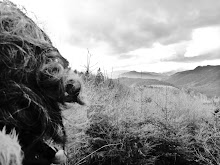Chris T fades into the last move at Off Broadway
getting buried in the curl - Robe Canyon, WA
By Brett Barton
A great boof–one that flows and feels like “you nailed it”–is all
about timing. A strong paddle stroke is important, but a good boof
requires a lot more than that. Let’s break it down and learn why.
Timing is critical to a good boof. A well-timed
stroke combined with proper body mechanics are the first steps to
sailing off the lip of a pour-over or across a nasty hydraulic, but this
technique can be practiced in Class II and III wave trains. Think about
pulling that last stroke just as your boat’s bow reaches the top of the
wave. Ideal timing happens when the wave is giving maximum lift to the
front of your boat
timed with a solid, powerful stroke that
will send the boat straight downstream, not making it spin out one way
or the other upon landing. Learning this spit second of timing takes
time. For the up-and-coming boofer, it may be easier and less
intimidating practicing in wave trains rather than going to the local
park-and-huck.

Ben K styles the main ledge at Paranoia on the Top Tye, Wa
It’s also all about the
stroke. A well-timed stroke
placed at the lip is pretty helpful, especially if you aren’t going very
fast. We’ll get to speed in a minute, but first practice this. Envision
yourself paddling to the lip and identifying the location where you’re
going to take that last stroke. As you pull back with your paddle and
fly off, spot your landing. While falling, watch your boat land and
notice the angle: Are you flat or 45in’ it? Or did you go too slow and
grind out at the lip, penciling into the water below? Rinse and repeat!

single-handed boof: studies show about 60% of the time
Benny nails it er'ry time
Good body mechanics equals good boofing. What
happens to your body when you boof? Tucking the knees up and leaning
forward as you drop are two important body mechanics to work on. This is
what gets the bow up and keeps it there. The longer you hold it, the
flatter you’ll land. Combine that tuck with a powerful stroke, and
you’ll begin to feel the timing aspect flow into the boof.
Though it may sound counterintuitive to aspiring creekboaters,
playboating downriver
is a great way to practice and develop the body mechanics for boofing
as well as other important river knowledge. Running rapids in a play
boat will put you that much more in touch with the current and how you
move with it. The same stroke you take for a boof can easily be a stroke
for a blunt or pan am. It all comes down to how you leverage (and time)
the brief surge the river gives you.
River levels are pretty important once you have
timing down as they can affect how your boat travels off a wave or a
rocky ledge. Two things come into play with levels:
speed and braking.
When the river is high, it’s moving fast downstream; moving fast is
important in that it helps you get and keep that bow up. When it’s low,
the ledge might be shallow or the wave might not be as tall. A low level
means you’ll have to paddle harder to achieve the same speed going off
that ledge so the bow doesn’t drop prematurely. Low levels usually
expose more rock as well and you run the risk of grinding out at the lip
and plugging in, instead of boofing out. Even if the features has a
little kicker and auto-boofs, you still have to be going fast and pull
those knees up (all the way down).

getting a little lean at the lip on Box Drop - Top Tye, WA
Other things to consider are the shape of the lip
and what part of the lip you’ll be paddling off. Does it have enough
water, or will you lose your momentum hitting the rock? Will you be
paddling straight downstream or cross-grain? What’s the hole like at the
bottom, is there anything to watch out for like an undercut wall or bad
pothole? Will you be able to muster enough speed to boof successfully?
If you’re boofing, you gotta have that
roll dialed.
We’re all between swims and it’s nothing to dwell on. Everybody swims.
But what is important to focus on is slowing things down a little when
you’re in a tough spot. I know when I get into an uncomfortable
situation (we all do), I want to hurry up and get it over with. Instead,
try slowing it down a little and get back into the experience at hand
(rolling/boofing) rather than the anticipation and feelings associated
with having to roll or missing a boof. It’s okay to grumble once in a
while when upside down, but it’s generally good practice to avoid
kayaking in places that induce panic attacks.
Rolling, timing, body mechanics, river running skills and
boofing–they all flow together and take patience to learn. So give your
kayaking the time it takes to get it dialed. And make sure you’re having
fun while you do it!









